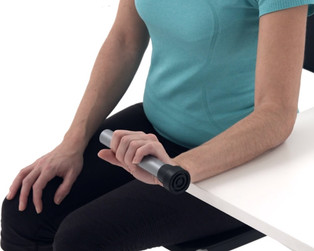Dumbbells: a friend to the upper limb
- Ame Harris

- 8 apr 2021
- 2 minuten om te lezen

Dumbbells or hand weights are probably the piece of exercise equipment people are most familiar with. It usually forms a staple in the home gym. That's also the reason why this series kicks off with dumbbells. Most people already have them at home but aren't aware of the uses in preventing and decreasing work-related pain and discomfort.
Shoulder strength is improved by using dumbbells. Strength training also improves our body's capacity to manage load, which makes us more resilient to pain. A recent study supported the success of a high-intensity shoulder exercise programme to decrease neck and shoulder pain in an office setting. See the below images for examples of shoulder strength exercises to do.
An important element to remember when performing shoulder strength training is to have sufficient resistance. The recommended number of repetitions, based on the above-mentioned study, is 12 - 15 reps max. Meaning that you have to choose your resistance accordingly to be completely fatigued after this amount of reps. Women tend to go lighter and perform more reps, but when focussing on strength, the weight must be enough to only perform the set amount of repetitions.
Dumbbells are also very useful for training the elbow and wrist. Working behind a computer all day means a lot of wrist and finger usage (sometimes overuse). Often resulting in elbow pain, similar to a tennis elbow. One of the best approaches to decrease or prevent this pain is to increase it's capacity to handle the stress placed upon it. That brings me back to strength training again.
There are some very specific principles to follow when training the elbow:
Start the exercises with the elbow supported and resting on a table. Preferably with the elbow bent at 90 degrees
Train in both directions of movement (up and down)
Control the movement. Do it slowly and in a controlled fashion
If you have existing pain, it's normal to have a little bit of pain while training
With pain in the elbow, stretching the muscle surrounding the joint also provides relief. By holding the wrist over the edge of the table before starting the training can elicit a stretch and decrease pain. For a stretch to be effective, it has to be maintained for at least 30 seconds. See below for examples of the stretch.
Another tip that works well in relieving elbow pains is have the shoulders relaxed. Regularly take breaks from typing or using the mouse. Remember to work with the elbows tucked at the sides and bent to a 90 degree angle.
Try to keep up the exercises for at least 8 weeks to experience tangible results. Place the dumbbells in a visible place as a reminder to do the exercises every day. These exercises are also effective in preventing pain and enabling you to work in a sustainable manner.
If you have any questions about working with pain, don't hesitate to contact Healthy Office or visit your nearest physiotherapist.
Photos courtesy of Physitrack
















